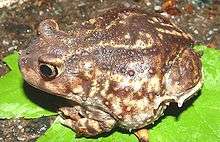Scaphiopus holbrookii
Scaphiopus holbrookii, commonly known as the eastern spadefoot, is a species of American spadefoot toad (family Scaphiopodidae) endemic to North America.[1][2]
| Scaphiopus holbrookii | |
|---|---|
 | |
| Scientific classification | |
| Kingdom: | Animalia |
| Phylum: | Chordata |
| Class: | Amphibia |
| Order: | Anura |
| Family: | Scaphiopodidae |
| Genus: | Scaphiopus |
| Species: | S. holbrookii |
| Binomial name | |
| Scaphiopus holbrookii (Harlan, 1835) | |
| Synonyms | |
Geographic range
It is found in the southeastern United States, except for mountainous areas, and is also found northward along the Atlantic coast, through the Mid-Atlantic states, into southern New England, including eastern Massachusetts. It is found in inland states such as Pennsylvania and New York, but only as far westward as the Appalachian Mountains, and the Hudson River Valley in New York.[3]
Description
The average length of an adult eastern spadefoot is 44–57 mm (1 3⁄4–2 1⁄4 in). It is brownish in color, with two yellowish stripes on its back. These stripes, which begin on the upper eyelids, may diverge or converge, resulting in a pattern resembling a lyre or an hourglass. Some specimens may be very dark, with less distinct markings.[3] It has one spur on each of its back feet for burrowing.[4] A similar species is Hurter's spadefoot toad, which was once considered a subspecies of S. holbrookii.[4]
Behavior
Scaphiopus holbrookii spends almost all of its life deep underground; coming out only to breed, and sometimes eat. It remains in a type of hibernation almost all its life. It burrows in a spiral, preferring sandy soils.
Research has looked into the habitat selection of the species, and has found that it tends to hover around upland areas. It has shown preference for being close to deciduous shrub edges, low-growing pitch pine branches, and reindeer lichen. This environment provides an easy place to burrow land, with dense prey biomass, and protection from predators.[5]
Conservation status
While not listed as an endangered species by the U.S. federal government, S. holbrookii is considered "threatened" in Massachusetts.[6] In that state and in 13 others, it is listed as a "Species of Greatest Conservation Need".[7]
Etymology
The epithet, holbrookii, is in honor of John Edwards Holbrook, American herpetologist.[8]
References
- IUCN SSC Amphibian Specialist Group (2015). "Scaphiopus holbrookii". IUCN Red List of Threatened Species. 2015: e.T59042A64981907. doi:10.2305/IUCN.UK.2015-2.RLTS.T59042A64981907.en.
- Frost, Darrel R. (2015). "Scaphiopus holbrookii (Harlan, 1835)". Amphibian Species of the World: an Online Reference. Version 6.0. American Museum of Natural History. Retrieved 4 January 2016.
- Conant, Roger. 1975. A Field Guide to Reptiles and Amphibians of Eastern and Central North America. Second Edition. Houghton Mifflin. Boston. 429 pp. ISBN 0-395-19977-8 (pbk.) (Scaphiopus holbrooki holbrooki, p. 299 + Plate 44 + Map 253.)
- "Eastern Spadefoot Toad". eNature. Retrieved 28 March 2016.
- Timm, Brad C., et al. “Upland Movement Patterns and Habitat Selection of Adult Eastern Spadefoots (Scaphiopus Holbrookii) at Cape Cod National Seashore.” Journal of Herpetology, vol. 48, no. 1, 2014, pp. 84–97., doi:10.1670/12-201.
- "Eastern Spadefoot Scaphiopus holbrookii" (pdf). List of Endangered, Threatened, and Special Concern species. Massachusetts Division of Fisheries & Wildlife. 2015. Retrieved 5 May 2020.
- "USGS map of S. holbrookii by state wildlife action plan (SWAP)" (dynamic map). USGS Core Science Analytics, Synthesis, and Libraries. USGS. Retrieved 5 May 2020.
- Bo Beolens; Michael Watkins; Michael Grayson (22 April 2013). The Eponym Dictionary of Amphibians. Pelagic Publishing. p. 96. ISBN 978-1-907807-44-2.
